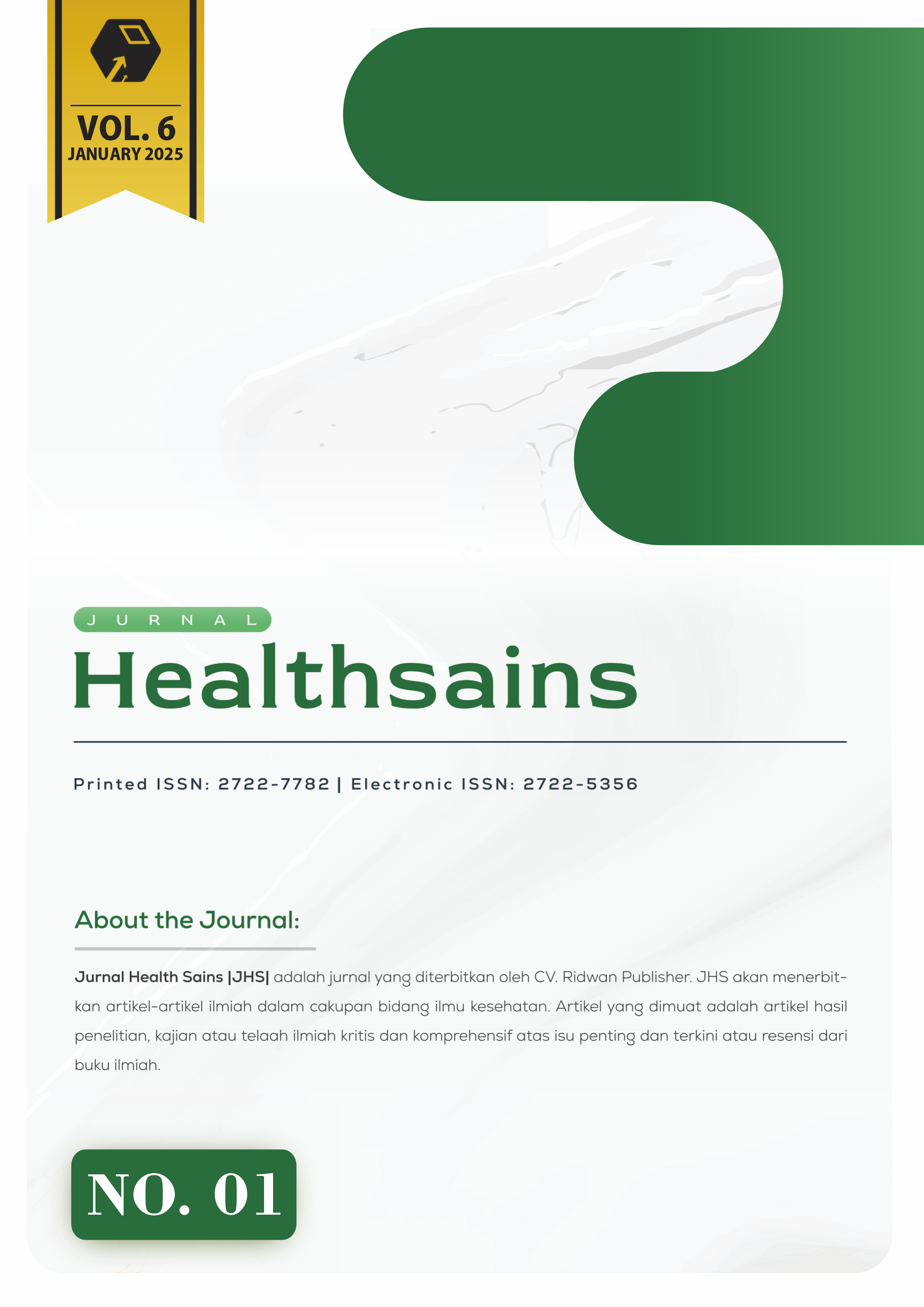Characteristics of Thyroid Nodule Patients Undergoing Radiofrequency Ablation (RFA) at RSUD Dr. Soetomo Surabaya from January 2023 to December 2024
DOI:
https://doi.org/10.46799/jhs.v6i1.1463Keywords:
concentrated platelets, platelet additive solution, platelet quality, buffy coat, shelf lifeAbstract
The availability of platelets in the Blood Donor Unit (UDD) of the Indonesian Red Cross (PMI) is relatively high each year. National data show that the number of platelet bags collected in 2019 reached 767,680 bags, increasing to 957,397 bags in 2021. However, the surge in dengue fever cases coinciding with the COVID-19 pandemic has nearly doubled the demand for concentrated platelets (TP) in hospitals since 2021. One method to extend platelet shelf life is the addition of platelet additive solution (PAS), which has not yet been implemented in Indonesia. This study aims to determine whether TP obtained through the buffy coat leukofiltered pooling method and stored with PAS can improve platelet quality during storage. The research methodology includes platelet quality analysis using several parameters, including platelet count, pH stability, and aggregation testing through adenosine diphosphate (ADP) examination of TP products over the storage period from day 0 to day 7. The results indicate that the addition of PAS helps maintain platelet quality, stabilize pH levels, and preserve platelet function during storage. This is made possible by the presence of key PAS components such as glucose, sodium acetate, sodium chloride, phosphate, magnesium, and potassium, which contribute to platelet stability and viability. The implications of this study suggest that implementing PAS in TP storage could serve as an effective solution for enhancing platelet availability while maintaining quality over an extended period. Therefore, adopting PAS in Indonesia’s platelet storage system could be a significant innovation to support blood supply sustainability, particularly in medical emergencies such as dengue fever outbreaks and pandemics.
References
Bernardi, S., Cesareo, R., Pacella, C., et al. (2019). Laser and radiofrequency ablation for benign thyroid nodules: Indications, techniques, and results. International Journal of Hyperthermia, 36(2), 654-662. https://doi.org/10.1080/02656736.2019.1585014.
Britannica. (2023). Thyroid gland: Anatomy, function, and disorders. Accessed through: https://www.britannica.com/science/thyroid-gland.
Cesareo, R., Palermo, A., Pasqualini, V., Manfrini, S., Trimboli, P., Stacul, F., Fabris, B., & Bernardi, S. (2020). Radiofrequency ablation of autonomous thyroid nodules: A critical appraisal and review of the literature. Frontiers in Endocrinology, 11(317). https://doi.org/10.3389/fendo.2020.00317
Che, Y., Jin, S., Shi, C., Wang, L., Zhang, X., Li, Y., & Baek, J.H. (2015). Treatment of benign thyroid nodules: Comparison of surgery and radiofrequency ablation. American Journal of Neuroradiology, 36(7), 1321-1325. https://doi.org/10.3174/ajnr.A4276.
Cibas, E.S. and Ali, S.Z. (2017) 'The 2017 Bethesda System for Reporting Thyroid Cytopathology', Thyroid, 27(11), pp. 1341-1346. doi:10.1089/thy.2017.0500.
Durante, C., Hegedüs, L., Czarniecka, A., et al. (2023). European Thyroid Association clinical practice guidelines for the management of thyroid nodules. European Thyroid Journal. https://etj.bioscientifica.com.
Erwin, D. Y., et al,. 2023. PERABOI Thyroid Cancer Management Guidelines 2023. Jakarta. PERABOI (Indonesian Association of Oncologic Surgeons). ISBN 978-602-71349-5-9
Guy's and St. Thomas' NHS Foundation Trust. (2023). Percutaneous ablation for thyroid nodules: Patient information. Retrieved from: https://www.guysandstthomas.nhs.uk/health-information/percutaneous-ablation-for-thyroid-nodules.
Ha, E.J., Baek, J.H., Lee, J.H., et al. (2015). Radiofrequency Ablation of Benign Thyroid Nodules and Recurrent Thyroid Cancers: Consensus Statement and Recommendations. Radiology and Endocrine Society Guidelines. Accessed via: https://doi.org/10.2214/AJR.15.15048.
Jasim, S., Patel, K.N., Randolph, G.W., et al. (2022). Utility of minimally invasive interventional procedures in benign and malignant thyroid lesions. Endocrine Practice, 28, 433-448. https://doi.org/10.1016/j.eprac.2022.02.011.
Kim, J.H., Baek, J.H., Lim, H.K., et al. (2012). Efficacy and Safety of Radiofrequency Ablation for Benign Thyroid Nodules: A Prospective Multicenter Study. Thyroid, 22(12), 1252-1258. Accessed via: https://doi.org/10.1089/thy.2012.0204.
Lim, D.J., Baek, J.H., Lee, J.H., et al. (2018). Long-Term Follow-Up Results of Ultrasound-Guided Radiofrequency Ablation for Benign Thyroid Nodules: A Prospective Multicenter Study. Endocrinology and Metabolism, 33(1), 1-8. Accessed via: https://doi.org/10.3803/EnM.2018.33.1.1.
Orloff, L.A., Noel, J.E. (2018). Radiofrequency Ablation and Its Evolving Role in the Treatment of Benign Thyroid Nodules. Head and Neck Surgery Guidelines, 40(3), 357-360. Accessed via: https://doi.org/10.1002/hed.25079.
Pacella, C.M., Mauri, G., Achille, G., et al. (2020). Outcomes of Ultrasound-Guided Percutaneous Radiofrequency Ablation for Benign Thyroid Nodules: A Systematic Review and Meta-Analysis. Thyroid, 30(6), 833-845. Accessed via: https://doi.org/10.1089/thy.2019.0707.
Shin, J.H., Baek, J.H., Chung, J., et al. (2017). Radiofrequency Ablation of Thyroid Nodules: 2017 Consensus Statement. Korean Society of Thyroid Radiology Guidelines. Accessed via: https://doi.org/10.14366/usg.17021.
Tessler, F.N. et al. (2017) 'ACR thyroid imaging, reporting and Data System (TI-RADS): White paper of the ACR ti-rads committee', Journal of the American College of Radiology, 14(5), pp. 587-595. doi:10.1016/j.jacr.2017.01.046.
Tufano, R.P., Pace-Asciak, P., Russell, J.O., et al. (2021). Update of radiofrequency ablation for treating benign and malignant thyroid nodules. Frontiers in Endocrinology, 12(698689). https://doi.org/10.3389/fendo.2021.698689.
Wong, R., Farrell, S. G., & Grossmann, M. (2018). Thyroid nodules: Diagnosis and management. The Medical Journal of Australia, 209(2), 92-94. https://doi.org/10.5694/mja17.01204.
Yi, K.H. (2016). Revised Korean Thyroid Association management guidelines for patients with thyroid nodules and cancers: Differences from the 2015 American Thyroid Association guidelines. Endocrinology and Metabolism, 31(3), 373-378. https://doi.org/10.3803/EnM.2016.31.3.373.
Downloads
Published
Issue
Section
License
Copyright (c) 2025 Muhammad Afifudin

This work is licensed under a Creative Commons Attribution-ShareAlike 4.0 International License.
Authors who publish with this journal agree to the following terms:
- Authors retain copyright and grant the journal right of first publication with the work simultaneously licensed under aCreative Commons Attribution-ShareAlike 4.0 International (CC-BY-SA). that allows others to share the work with an acknowledgement of the work's authorship and initial publication in this journal.
- Authors are able to enter into separate, additional contractual arrangements for the non-exclusive distribution of the journal's published version of the work (e.g., post it to an institutional repository or publish it in a book), with an acknowledgement of its initial publication in this journal.
- Authors are permitted and encouraged to post their work online (e.g., in institutional repositories or on their website) prior to and during the submission process, as it can lead to productive exchanges, as well as earlier and greater citation of published work.






